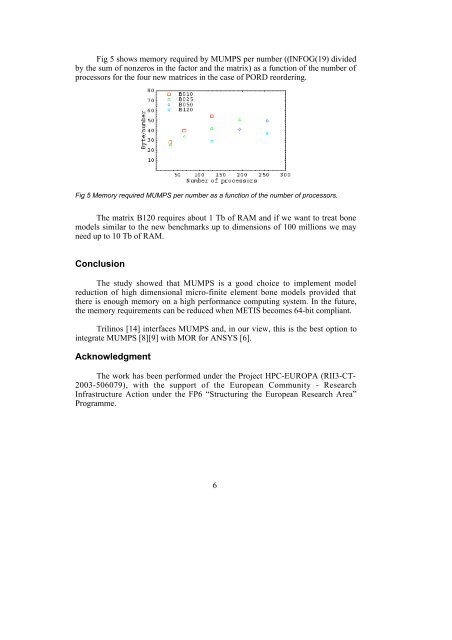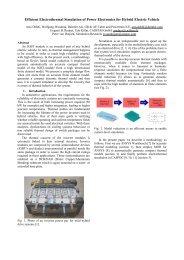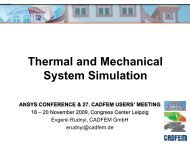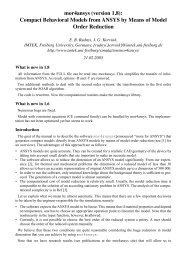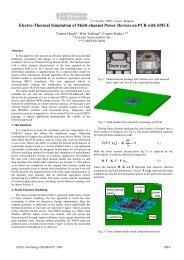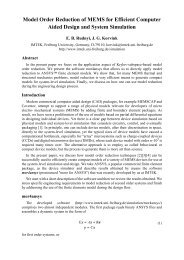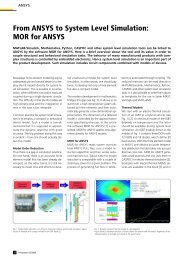Fig 5 shows memory required by MUMPS per number ((INFOG(19) divided by the sum of nonzeros in the factor and the matrix) as a function of the number of processors <strong>for</strong> the four new matrices in the case of PORD reordering. Fig 5 Memory required MUMPS per number as a function of the number of processors. The matrix B120 requires about 1 Tb of RAM and if we want to treat bone models similar to the new benchmarks up to dimensions of 100 millions we may need up to 10 Tb of RAM. Conclusion The study showed that MUMPS is a good choice to implement model reduction of high dimensional micro-finite element bone models provided that there is enough memory on a high per<strong>for</strong>mance computing system. In the future, the memory requirements can be reduced when METIS becomes 64-bit compliant. Trilinos [14] interfaces MUMPS and, in our view, this is the best option to integrate MUMPS [8][9] with MOR <strong>for</strong> ANSYS [6]. Acknowledgment The work has been per<strong>for</strong>med under the Project HPC-EUROPA (RII3-CT- 2003-506079), with the support of the European Community - Research Infrastructure Action under the FP6 “Structuring the European Research Area” Programme. 6
References [1] B. van Rietbergen, H. Weinans, R. Huiskes, A. Odgaard, A new method to determine trabecular bone elastic properties and loading using micromechanical finite-elements models. J. Biomechanics, v. 28, N 1, p. 69-81, 1995. [2] B. van Rietbergen, R. Huiskes, F. Eckstein, P. Rueegsegger, Trabecular Bone Tissue Strains in the Healthy and Osteoporotic Human Femur, J. Bone Mineral Research, v. 18, N 10, p. 1781 - 1787, 2003. [3] L. E. Lanyon, C. T. Rubin, Static versus dynamic loads as an influence on bone remodelling, Journal of Biomechanics, 17: 897-906, 1984. [4] E. B. Rudnyi, J. G. Korvink, Review: Automatic <strong>Model</strong> <strong>Reduction</strong> <strong>for</strong> Transient Simulation of MEMS-based Devices. Sensors Update v. 11, p. 3-33, 2002. [5] R. W. Freund, Krylov-subspace methods <strong>for</strong> reduced-order modeling in circuit simulation, Journal of Computational and Applied Mathematics, v. 123, pp. 395-421, 2000. [6] E. B. Rudnyi, J. G. Korvink. <strong>Model</strong> Order <strong>Reduction</strong> <strong>for</strong> Large Scale Engineering <strong>Model</strong>s Developed in ANSYS. Lecture Notes in Computer Science, v. 3732, pp. 349- 356, 2005. http://www.imtek.uni-freiburg.de/simulation/mor4ansys/ [7] E. B. Rudnyi, B. van Rietbergen, J. G. Korvink. Efficient Harmonic Simulation of a Trabecular Bone Finite Element <strong>Model</strong> by means of <strong>Model</strong> <strong>Reduction</strong>. 12th Workshop "The Finite Element Method in Biomedical Engineering, Biomechanics and Related Fields", University of Ulm, 20-21 July 2005. Preprint at http://www.imtek.uni-freiburg.de/simulation/mor4ansys/pdf/rudnyi05ulm.pdf. [8] P. R. Amestoy, I. S. Duff, J. Koster and J.-Y. L'Excellent, A fully asynchronous multifrontal solver using distributed dynamic scheduling, SIAM Journal of Matrix Analysis and Applications, v. 23, No 1, pp 15-41 (2001). [9] P. R. Amestoy and A. Guermouche and J.-Y. L'Excellent, S. Pralet, Hybrid scheduling <strong>for</strong> the parallel solution of linear systems. Parallel Computing, v. 32 (2), pp 136-156 (2006). http://graal.ens-lyon.fr/MUMPS/ [10] J. G. Korvink, E. B. Rudnyi. Oberwolfach Benchmark Collection. In: Benner, P., Mehrmann, V., Sorensen, D. (eds) Dimension <strong>Reduction</strong> of Large-Scale Systems, Lecture Notes in Computational Science and Engineering (LNCSE). Springer-Verlag, Berlin/Heidelberg, Germany, v. 45, p. 311-315, 2005. http://www.imtek.unifreiburg.de/simulation/benchmark/ [11] G. Karypis, V. Kumar, A fast and high quality multilevel scheme <strong>for</strong> partitioning irregular graphs, SIAM Journal on Scientific Computing, Vol. 20, N 1, 1998, pages 359-392. http://glaros.dtc.umn.edu/gkhome/views/metis/metis/ [12] J. Schulze, Towards a tighter coupling of bottom-up and top-down sparse matrix ordering methods, BIT, Vol. 41, No. 4, pp. 800–841, 2001. [13] G. Karypis, Private communication, 2006 [14] M. A. Heroux, R. A. Bartlett, V. E. Howle, R. J. Hoekstra, J. J. Hu, T. G. Kolda, R. B. Lehoucq, K. R. Long, R. P. Pawlowski, E. T. Phipps, A. G. Salinger, H. K. Thornquist, R. S. Tuminaro, J. M. Willenbring, A. Williams, K. S. Stanley, An overview of the Trilinos project, ACM Trans. Math. Softw., v. 31, N 3, p. 397-423, 2005. http://software.sandia.gov/trilinos/


